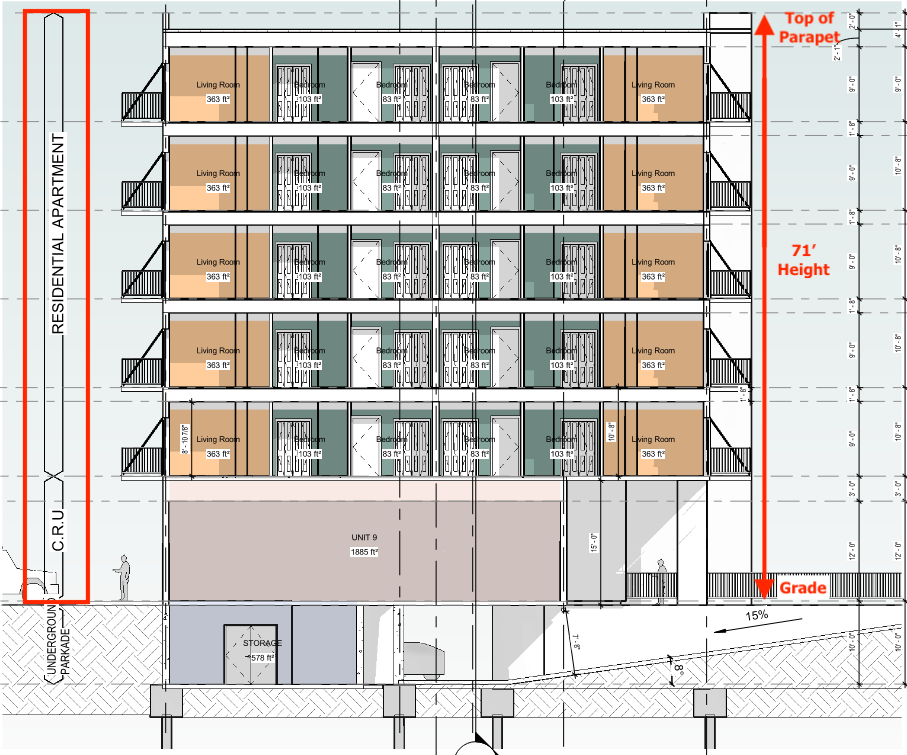On June 17, a group of local developers were tasked with selling their concept for Niverville’s first six-storey complex to both council and the general public.
At a public meeting held in council chambers, Ray Dowse, on behalf of Fairway Vistas Inc., asked for a variation request which would allow the construction of a multiuse complex at 400 and 500 Drovers Run.
After much discussion and debate, council voted unanimously in favour of the request.
Once built, it will house commercial units on the main level and residential units in the five levels above. The variation application included a request to build to a maximum of 71 feet from grade to façade parapet, making it the tallest building in Niverville community to date.
Three residents approached council to voice their disapproval, not with the development or developers but with the idea of a six-storey building in general.
One voiced their approval of the idea.
Two letters of opposition were read into the public record. As well, council made note of a petition they’d received which voiced disapproval over such a six-storey complex. It contained 281 signatures, only 122 of which council could be confirmed as belonging to Niverville residents.
Fairway Vistas Makes Their Case
Delegates at Tuesday’s council meeting included Dowse and two of his partners, Bryan Trottier and Wes Dowse. The team came prepared with a series of visual displays to accompany their presentation.
Prior to opening the public hearing, Mayor Myron Dyck reminded those gathered that the issue at hand was the specific building, not residential growth in general.
“There’s people that have concerns about small town feel and how big the community’s getting,” Dyck said. “This [hearing is only] about the height of a building… If this [request] is passed, then formal development plans will have to come to council… where it’ll need to meet provincial requirements for drainage and municipal standards for parking and everything from where the lights go to where signage goes.”
As part of Dowse’s opening presentation, he reminded those gathered that his local company has been an active developer in Niverville for the past 15 years, not an outsider interested in mere profit margins.
Over the years, they’ve been responsible for the restoration of much of Niverville’s Main Street, taking down or refurbishing old buildings and turning out aesthetically pleasing commercial units for both new and established businesses.
Examples include the business mall located at 226 Main Street, which is the site of Anya’s Hair Studio on the east end of Main. Towards the west side, there’s the Canada Post and One Insurance building, which sits next door to Niverville Physio, barBURRITO, and Santa Lucia Pizza.
Fairway Vistas is also responsible for most of the new commercial development along Drovers Run on the west side of the railway tracks, including virtually everything between Smitty’s Restaurant and the Shell gas station.
“Over the course of [the last] ten years, we’re proud to have 14 businesses occupying roughly 35,000 square feet at those sites,” Dowse said.
Six years ago, the team began looking at adding multifamily housing to their business endeavours.
That decision, he said, was in response to Statistics Canada data indicating that renter households are now significantly outpacing owner households.
“Before 2011, apartments accounted for less than 40 percent of building permits. But in 2021, they accounted for 73.2 percent of building permits in Canada,” Dowse said. “These stats translate directly to what we’re seeing in Niverville.”
Combining commercial builds with residential, as this team proposes, is simply a more cost-effective model for everyone involved, from builder to resident.
“The roughly 100 residential suites [will] mitigate commercial occupancy costs for businesses so we can continue accommodating commercial entities looking for entry points in the community,” said Dowse.
As for the proposed location, Dowse says it’s ideal considering that this zone is already established with multifamily and commercial units. As well, it’s optimally located for easy access to a wide range of commercial and recreational amenities and is in close proximity to schools and the downtown area.
In defending his proposed 71-foot height, which is what is needed for a six-storey building, he points out that it’s not that very big a stretch from the 50-foot Jette Studios building or the 57-foot Heritage Centre.
“This site is ideal for taller buildings being that it is a commercial site with Main Street frontage,” Dowse argued. “It’s not in the core area of town, it’s not in Fifth Avenue Estates or The Highlands, and it does not back onto bungalows or single-family dwellings.”
Dowse then presented a graphic used by the person responsible for the petition that had been circulated prior to the public meeting. It depicted a 16-storey skyscraper at the heart of a neighbourhood of single-family dwellings.
“If I saw that rendering for a project here in Niverville, I’d have concerns of my own,” Dowse said. “I want to assure everyone that this is very misleading and not an accurate representation of what’s being proposed on this site.”
At the same time, Dowse said he doesn’t recommend that council create a carte blanche bylaw endorsing all six-storey builds going forward. Instead he suggests that approval should be given on a case-by-case basis.
Addressing Concerns
One by one, three residents stepped forward to address council.
“I see the stretch of going from three- to six-storeys as a big leap,” said one resident. “Prior to moving to Niverville I lived in Sage Creek and I saw, in the time that we lived there, land getting repurposed, based on the growth of Sage Creek, into five- to six- or even eight-storey apartment buildings and condos. It really changed the feel of the community.”
By the time they had their first child, he added, the area had grown to the degree that kids were being bussed out of the community to schools in other parts of the city.
“It’s looking like the city across the street from my house,” stated another resident living on Church Street. “This sets a precedent. Now [in the new empty development] beside me, they’re going to say, ‘Well, this guy got a six-storey building,’ and so it will go.”
She queried whether buildings of this size ae being seen in other small towns in Manitoba.
Mayor Dyck was able to name a few such buildings in the city of Steinbach. While Steinbach is not a small town, he argued that Niverville is set to become Manitoba’s next city very soon.
“Are we slamming the door [to residential development] today?” Dyck asked rhetorically. “Are we slamming the door next year? When are we slamming the door?”
Councillor Meghan Beasant also weighed in, suggesting that closing the door to residential growth means limiting the potential for businesses who operate in Niverville. As well, she said, it doesn’t consider the needs of future generations in terms of housing.
“In ten years, my child is going to need somewhere to live. And unless I can provide him with a down-payment for a home, not likely, they’ll need to have options,” Beasant said. “I would rather see the options be here than to say to my child, ‘This town has not planned for your future. You need to go elsewhere.’”
Counsellor Nathan Dueck, too, had something to say.
Prior to 2018, he said, town zoning bylaws allowed for buildings up to eight storeys in height. In 2018, council changed the bylaw, making it a requirement for a public hearing to be held when a proposal is received for a new build which exceeds two storeys. This was done to allow for public input with every such proposal.
To further assure residents of council’s intentionality, Mayor Dyck indicated that conversations surrounding the look of the future Niverville take place on a regular basis around their boardroom table.
“Are we going to have six-storey buildings up and down Main Street so you feel like you’re driving through a tunnel?” Dyck asked. “Those are conversations we have.”
To prevent that, Dyck says they follow commonly used development design guidelines. Typically, commercial development would run alongside major thoroughfares, followed by multistorey housing behind, and finally single-family dwellings would take up the rear.
To the question of school capacity keeping up with growth, Dueck had more to say.
“We’ve had the opportunity in the last two weeks to meet with the premier… to pitch the idea of Niverville becoming the next city,” said Dueck. “[We needed them to recognize] the need for more money for roads and infrastructure, for schools, for healthcare… We are very much on the radar of the capital region and the existing government for preparing to become the best city in Manitoba in the next year or two.”

The design of the new six-storey, 71-foot mixed used building to be built along Drovers Run.


